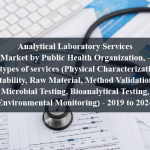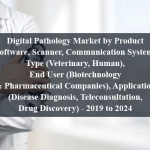OVERVIEW
The Rapid Microbiology Testing Market is currently valued at USD 5.2 billion in 2024 and will be growing at a CAGR of 10.1 % over the forecast period to reach an estimated USD 8.3 billion in revenue in 2029. The rapid microbiology testing market is characterized by its pivotal role in providing swift and accurate identification of microbial contaminants in various industries, including pharmaceuticals, food and beverages, clinical diagnostics, and environmental testing. This burgeoning market is fueled by the increasing emphasis on quality control and assurance, stringent regulatory standards, and the need for expedited results to ensure product safety and efficacy. Rapid microbiology testing methods, such as polymerase chain reaction (PCR), immunoassays, and nucleic acid amplification techniques, offer significant advantages over traditional culture-based methods, including reduced time-to-results, enhanced sensitivity and specificity, and automation capabilities. Moreover, the advent of novel technologies, such as microfluidics and miniaturized platforms, is further revolutionizing the landscape by enabling on-site and point-of-care testing, thereby streamlining workflows and minimizing reliance on centralized laboratories. As industries continue to prioritize efficiency, reliability, and cost-effectiveness, the rapid microbiology testing market is poised for continued expansion and innovation, driven by ongoing research and development efforts aimed at addressing emerging challenges and market demands.
One significant factor is the increasing global focus on ensuring product safety and quality across various industries, including pharmaceuticals, food and beverages, clinical diagnostics, and environmental testing. Stringent regulatory requirements mandate rigorous testing protocols to mitigate the risk of microbial contamination, driving the demand for rapid microbiology testing solutions that offer timely and accurate results. Moreover, the growing prevalence of infectious diseases and foodborne illnesses underscores the critical need for efficient microbial detection methods to safeguard public health. Additionally, advancements in technology, such as automation, miniaturization, and molecular techniques like PCR, are enhancing the speed, sensitivity, and specificity of microbiology testing, further fueling market growth. Furthermore, the shift towards decentralized testing models and point-of-care solutions is driving the adoption of rapid microbiology testing systems, enabling real-time decision-making and improving operational efficiency. As industries increasingly prioritize quality assurance, regulatory compliance, and consumer safety, the rapid microbiology testing market is poised for continuous expansion and innovation.
Market Dynamics
Drivers:
One significant factor is the increasing global focus on ensuring product safety and quality across various industries, including pharmaceuticals, food and beverages, clinical diagnostics, and environmental testing. Stringent regulatory requirements mandate rigorous testing protocols to mitigate the risk of microbial contamination, driving the demand for rapid microbiology testing solutions that offer timely and accurate results. Moreover, the growing prevalence of infectious diseases and foodborne illnesses underscores the critical need for efficient microbial detection methods to safeguard public health. Additionally, advancements in technology, such as automation, miniaturization, and molecular techniques like PCR, are enhancing the speed, sensitivity, and specificity of microbiology testing, further fueling market growth. Furthermore, the shift towards decentralized testing models and point-of-care solutions is driving the adoption of rapid microbiology testing systems, enabling real-time decision-making and improving operational efficiency. As industries increasingly prioritize quality assurance, regulatory compliance, and consumer safety, the rapid microbiology testing market is poised for continuous expansion and innovation.
Key Offerings:
In the rapidly evolving landscape of microbiology testing, key offerings encompass a diverse array of solutions designed to meet the varied needs of industries such as pharmaceuticals, food and beverages, clinical diagnostics, and environmental testing. Advanced molecular techniques, including polymerase chain reaction (PCR) and nucleic acid amplification, form a cornerstone of these offerings, providing rapid and precise identification of microbial contaminants. Additionally, innovative immunoassays and biosensor technologies offer sensitive detection of specific pathogens and antigens, enhancing the diagnostic capabilities across different sectors. Automation and robotics play a crucial role in streamlining workflows, improving throughput, and reducing human error, thereby increasing the efficiency and reliability of microbiology testing processes. Furthermore, portable and point-of-care testing platforms empower decentralized testing, enabling on-site analysis and real-time monitoring in diverse environments. Integrated software solutions for data management, analysis, and regulatory compliance complement these offerings, providing comprehensive support throughout the testing lifecycle.
Restraints :
While the rapid microbiology testing market shows promising growth prospects, several restraints pose challenges to its expansion. One significant constraint is the high initial capital investment required for implementing advanced technologies and automated systems. This financial barrier can limit the adoption of rapid microbiology testing solutions, particularly among small and medium-sized enterprises with constrained budgets. Additionally, concerns regarding the standardization and validation of rapid testing methods may hinder widespread acceptance, especially in regulated industries where compliance with stringent quality standards is paramount. Furthermore, the complexity of sample matrices and the diversity of microbial contaminants present in different applications can pose challenges to the development of universally applicable testing protocols, leading to variability in results and undermining confidence in the technology. Moreover, the shortage of skilled personnel proficient in operating and interpreting data from sophisticated microbiology testing systems could impede market growth.
Regional Information:
• In North America, the rapid microbiology testing market is driven by stringent regulatory frameworks, particularly in pharmaceuticals and food safety, prompting companies to invest in advanced testing solutions to ensure compliance. The presence of key market players and robust healthcare infrastructure further fuels market growth.
• In Europe, increasing awareness of foodborne illnesses and stringent food safety regulations propel the demand for rapid microbiology testing solutions in the food and beverage industry. Additionally, government initiatives promoting the adoption of innovative healthcare technologies contribute to market expansion.
• In the Asia-Pacific region, rapid urbanization, rising healthcare expenditure, and growing awareness of infectious diseases drive market growth. Moreover, the emergence of economies such as China and India as manufacturing hubs for pharmaceuticals and food products accelerates the adoption of rapid microbiology testing technologies to ensure product quality and safety.
Recent Developments:
• In December 2023, Danaher Corporation (US) acquired Abcam (UK), a company that offers the scientific community validated antibodies, reagents, biomarkers, and assays to address targets in biological pathways that are critical for advancing drug discovery, life sciences research, and diagnostics.
• In May 2023, bioMérieux SA (France) received the US Food and Drug Administration (FDA) Clinical Laboratory Improvement Amendments (CLIA) waiver for the fast and accurate multiplex PCR-based BIOFIRE SPOTFIRE Respiratory (R) Panel Mini.
Key Players:
BioMérieux SA, Thermo Fisher Scientific Inc., Danaher Corporation, Becton, Dickinson and Company, Merk KGaA, QIAGEN N.V., Abbott Laboratories, Bruker Corporation, 3M Company, and Neogen Corporation.
1) What is the projected market value of the Rapid Microbiology Testing Market?
– The Rapid Microbiology Testing Market is expected to reach an estimated value of USD 8.3 billion in revenue by 2029.
2) What is the estimated CAGR of the Rapid Microbiology Testing Market over the 2024 to 2029 forecast period?
– The CAGR is estimated to be 10.1% for the Rapid Microbiology Testing Market over the 2024 to 2029.
3) Who are the key players in the Rapid Microbiology Testing Market?
– BioMérieux SA, Thermo Fisher Scientific Inc., Danaher Corporation, Becton, Dickinson and Company, Merk KGaA, QIAGEN N.V., Abbott Laboratories, Bruker Corporation, 3M Company, and Neogen Corporation.
4) What are the drivers for the Rapid Microbiology Testing Market?
– The global focus on product safety and quality in industries like pharmaceuticals, food, and clinical diagnostics is driving demand for rapid microbiology testing solutions. Advancements in technology, automation, and decentralized testing models are enhancing the speed, sensitivity, and specificity of testing. As industries prioritize quality assurance, regulatory compliance, and consumer safety, the rapid microbiology testing market is poised for continuous expansion and innovation.
5) What are the restraints and challenges in the Rapid Microbiology Testing Market?
– The rapid microbiology testing market faces challenges due to high initial capital investment, standardization concerns, sample matrices complexity, and diversity of microbial contaminants. These factors limit adoption among small and medium-sized enterprises, hindering widespread acceptance in regulated industries. Additionally, a shortage of skilled personnel in operating and interpreting data from sophisticated systems could impede market growth.
6) What are the key applications and offerings of the Rapid Microbiology Testing Market?
– Microbiology testing offers various solutions for industries like pharmaceuticals, food and beverages, clinical diagnostics, and environmental testing. Advanced molecular techniques, immunoassays, biosensor technologies, automation, robotics, portable platforms, and integrated software solutions enhance diagnostic capabilities. Automation streamlines workflows, reduces human error, and enables on-site analysis and real-time monitoring. These solutions provide comprehensive support throughout the testing lifecycle.
7) Which region is expected to drive the market for the forecast period?
– North America is expected to have the highest market growth from 2024 to 2029
Why Choose Us?
Insights into Market Trends: Global Market Studies reports provide valuable insights into market trends, including market size, segmentation, growth drivers, and market dynamics. This information helps clients make strategic decisions, such as product development, market positioning, and marketing strategies.
Competitor Analysis: Our reports provide detailed information about competitors, including their market share, product offerings, pricing, and competitive strategies. This data can be used to inform competitive strategies and to identify opportunities for growth and expansion.
Industry Forecasts: Our reports provide industry forecasts, which will inform your business strategies, such as investment decisions, production planning, and workforce planning. These forecasts can help you to prepare for future trends and to take advantage of growth opportunities.
Access to Industry Experts: Our solutions include contributions from industry experts, including analysts, consultants, and subject matter experts. This access to expert insights can be valuable for you to understand the market.
Time and Cost Savings: Our team at Global Market Studies can save you time and reduce the cost of conducting market research by providing comprehensive and up-to-date information in a single report, avoiding the need for additional market research efforts.












